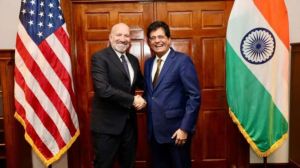RBI new Governor Sanjay Malhotra’s first agenda: Rate cut in February?
The new Governor inherits a fairly stable financial, monetary ecosystem unlike his predecessors
 Sanjay Malhotra takes charge as new RBI Governor. (Photo: X/@RBI)
Sanjay Malhotra takes charge as new RBI Governor. (Photo: X/@RBI)Sanjay Malhotra takes charge at the Mint Street headquarters of the Reserve Bank of India (RBI) at a time when the country’s financial system and the economy in general are broadly charting a stable phase, with an interest rate cut looming in the horizon. This is unlike his predecessors who mostly faced turbulent times when they took over the Governor’s post.
How former Governors kicked off terms
D Subbarao who took over as the RBI Governor on September 5, 2008, faced baptism by fire as the country’s economy was hit by the global financial crisis triggered by the collapse of the Lehman Brothers. Subbarao cut the repo rate from 8.5–9 per cent to 3.5 per cent over a period of six months as Indian financial system was hit by the global crisis. He also cut the CRR and SLR — amounts that banks have to keep with the RBI — to historically low levels to tackle the crisis.
On September 5, 2013, hours after taking over as the new governor of the Reserve Bank of India, Raghuram Rajan was forced to announce a bold blueprint for the financial sector at a time when the economy is faced with a multi-pronged crisis of high consumer price inflation, industrial slowdown, a free fall of the rupee and a widening current account deficit (CAD). These measures were aimed at stabilising the Indian economy after taper tantrum, or tapering of quantitative easing in the US, rocked the global markets again.
Faced with the taper tantrum, Rajan announced plans to internationalise the rupee, float inflation bonds linked to the consumer price index, steps to boost exports and increase inflows, plans to review the monetary policy process and gave banks the freedom to open branches without having to approach the RBI for licences.
Soon after Urjit Patel became the Governor in 2016, the government announced demonetisation of Rs 1000 and Rs 500 notes and Patel, who didn’t oppose the plan, had a tough time in handling the banking system during the note withdrawal phase. Soon thereafter, he was involved in a major feud with the Finance Ministry on the issue of giving higher surplus dividend to the government which ultimately led to his exit.
Shaktikanta Das, armed with the knowledge of his experience in the Finance Ministry, started on a quiet note in December 2018 but the Covid pandemic in early 2020 forced him to change the dynamics of central banking. During the pandemic, Das reduced the repo rate by 125 basis points to revive the economy and offered a loan moratorium to mitigate the adverse impact of the pandemic.
The last mile disinflation challenge and questions over economic projections
For Malhotra, there could be some challenges, but not as tough as those faced by his predecesors. While the GDP growth decelerated to 5.4 per cent in the second quarter ended September, the RBI has projected Q3 growth higher at 6.8 per cent and Q4 at 7.2 per cent. And if the CPI inflation for 2024-25 which is projected at 4.8 per cent manages to remain at that level, Malhotra will be all set to go for a cut in Repo rate in the February monetary policy review. Whether it will be 25 bps or 50 bps is the moot question.
However, former Governor Das indicated last week that slowdown in domestic economic activity bottomed out in the second quarter (Q2) of 2024-25, and has since recovered, aided by strong festive demand and pick up in rural activities.
It was seen that Governors coming from the government side are predisposed to lean in favour of what the government’s views are on the growth-inflation dynamics, but eventually they change their working ethos and integrate into the RBI culture. The internal bureaucracy in the RBI is very strong and they don’t generally subscribe to the wishes of the government, according to offcials. This was evident in the case of D Subbarao, YV Reddy and even Shaktikanta Das at a later stage.
The government, which was expecting a rate cut in the December policy review, will also want the rate cut happen. Days before the end of the tenure of Das, two union ministers called for a cut in the repo rate ahead of the monetary policy review on December 8. Finance Minister Nirmala Sitharaman batted for “affordable bank interest rates” to support industries to ramp up and build capacities. Union Minister for Commerce and Industry Piyush Goyal also urged the RBI to cut interest rates to boost economic growth and look through food prices while deciding on monetary policy.
However, much against the wishes of the government, the RBI, which is keen to bring inflation under control, kept the Repo rate unchanged at 6.50 per cent. This goes against the claim of Das on Tuesday that the co-ordination between the government and the RBI was “at its best” in the last six years.
There was also a proposal to exclude food inflation from the CPI inflation from the government side in order to facilitate a reduction in interest rates. This stoutly opposed by Das and the RBI.
In 2018-19, after Das, who was with the government earlier, became the Governor, the RBI made the highest surplus transfer was Rs 176,051 crore. This is after his predecessor Urjit Patel stoutly opposed a high surplus transfer to the government. In FY2024, the RBI, under Das, declared a bonanza to the Central Government, approving a massive, all-time high surplus transfer of Rs 210,874 crore.
Clearly, the government wants the RBI to cut the rate to boost the GDP growth. “We believe that the next MPC policy in February 2025 may announce a repo rate cut of 25 bps. The RBI has been adopting a calibrated approach so far but as the slowdown in growth becomes more apparent, the RBI will need to provide monetary support,” said Puneet Pal, Head- Fixed Income, PGIM India Mutual Fund.





- 01
- 02
- 03
- 04
- 05


























